Repair technology with cutting cards using cast asphalt mixtures
Since the 30s of the 19th century, asphalt has dominated road construction. Thanks to the technology of its even laying, it is possible to reduce the noise of passing cars. If even for a second the current flow of vehicles is on cobblestone paving stones, it is difficult to imagine the state of our eardrum.
Concentrated road workers with shovels near smoking piles of hot asphalt and skating rink hither and thrilling with its massiveness is a common sight for citizens who do not allow any alternative to paving the city as a criterion for its improvement.
However the appearance paved asphalt destroyed stereotypes of laying works on city streets. It turns out that you can do without a skating rink. In principle, the same components, but ... their proportion has changed. As a result of simple know-how, laying technology has changed asphalt pavementimproved surface layer quality pavement.
Features of the composition of cast asphalt
Component traditional ingredients of the average asphalt are preserved in the cast asphalt, but their ratio is fundamentally different than in the classic version. In cast asphalt, the proportion of sand and gravel is reduced, and the content of bitumen is increased. Cast asphalt may contain up to 13% of the bitumen component, and the temperature of preparation and subsequent laying of asphalt should be in the range of 200-250 degrees C.
Cast asphalt is a type of hot asphalt mix. This modification was named cast because the hot asphalt cast for paving sidewalks and roads acquires a viscous-fluid moving consistency, making it suitable for pouring prepared surfaces. The mixture spreads in an even layer, completely without the need for compaction, as is required when using traditional asphalt mixes.
The best indicators of elasticity, wear resistance, frictional properties, water resistance and fatigue life are demonstrated by molten polymer-asphalt concrete obtained using modified polymer-bitumen binders. GOST R 54401 recommends the use of molded polymer-asphalt concrete on all types of bridge structures and on roads exposed to increased loads from vehicles. 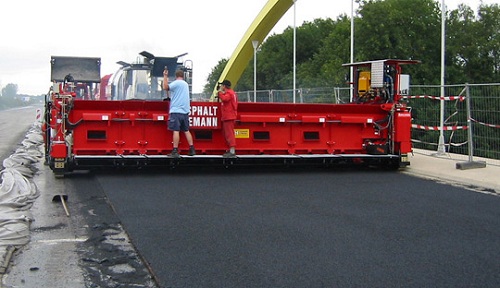
Features of paving cast asphalt
The process of laying paved asphalt is not complicated in itself. Asphalt mixture is poured onto the surface of the site and leveled using special mechanisms or even manually. No rollers are required. The number of road workers involved is minimized; the road will be ready to receive loads in a few hours.
Cast asphalt has high water resistance, it can also be laid when it rains. But in order to preserve its functional properties by cast asphalt, careful observance of technology is required, which requires maintaining the temperature of the mixture in strictly regulated limits. 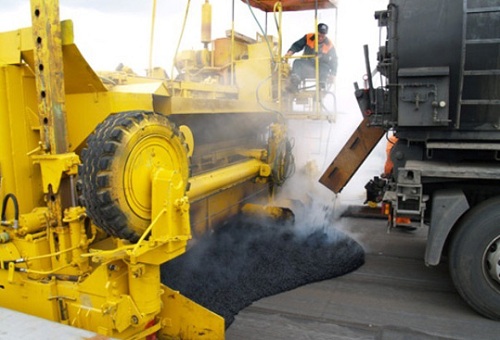
Transportation produced asphalt mix from the producer of cast asphalt to the place of consumption is carried out in special vehicles - kocher. Kochers are mobile tank-tanks that maintain the desired state of the mixture, heating it and mixing during transportation. Already at the facility, the delivered mixture is poured, providing a uniform distribution of the asphalt layer on the surface. The thickness of the fill layer should be between 25-30 mm, for a larger thickness several layers are required.
It is important! For mixtures laid on especially important bridge structures or overloaded highways and city streets, it is necessary to increase workability with special additives. From this, the viscosity increases slightly, which makes manual styling inconvenient.
The cost of cast asphalt with such an apparent simplicity of laying is much higher than traditional compositions and technologies, since the rise in price is due to the use of expensive bitumen and mineral powders, as well as special road pavers and coaches. Therefore, the use of cast asphalt in Russia is very limited.
It is a complex structural compound widely used for construction purposes. The main difference between cast asphalt and asphalt concrete is the procedure for laying it.
Mix making
The composition of the cast asphalt includes the same components as for asphalt concrete, however, the proportions for the batch are different. The main components of the cast mixture are crushed stone, sand, and bitumen. However, the ingredients themselves are slightly different in composition. Sand is used of natural origin or from rock screenings, and mineral powder is made from highly active
The amount of bitumen and powder is significantly higher than that of asphalt concrete, which makes the cast option more ductile and ductile. Most manufacturers use asphalt chips in the manufacture of the cast mixture, which undoubtedly reduces the cost of the creation process. pavement, but adversely affects its properties.
Specifications
The main advantage of this type of coating is its complete waterproofness due to its solid, rather than porous structure, which increases durability and expands the scope. Subject to the technological requirements during manufacturing, the service life of cast asphalt reaches half a century, which is significantly longer than the service of asphalt concrete.
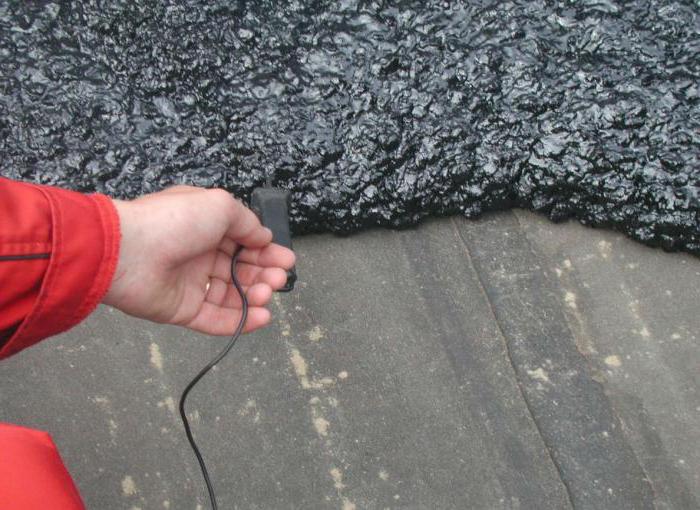
The use of such mixtures allows you to make the pavement smoother and reduce the thickness, without losing the sealing properties. This type of asphalt concrete has increased corrosion and wear-resistant characteristics, is resistant to temporary changes and fatigue damage, and is also able to withstand huge deformation strain. Cast asphalt is more resistant to damage by tracked vehicles or studded tires, withstands sudden changes in temperature and prolonged thermal exposure. It does not require the use of a sealing mixture, and repair of the coating can also be carried out during low temperatures.
disadvantages
However, this coating has negative qualities, which include the high cost of manufacture due to the use of an increased number of expensive components, as well as the need to use professional equipment for laying and replacing asphalt (specialized thermo-mixers and heaters). In addition, due to the high content of bitumen, astringent indicators of the pavement suffer, due to which there is a need for additional work on pressing black gravel onto an installed layer asphalt pavement.
Cast Asphalt Technology
The technique itself is not innovative. The production of cast asphalt is carried out at asphalt plants in special bitumen-mixing structures, similar to huge concrete mixers, using a technology similar to the manufacture of ordinary asphalt concrete. The finished mixture has a high temperature (from 200 C), which is maintained until the material is used for its intended purpose. When transporting cast asphalt, it is necessary to constantly mix the mixture and maintain a high temperature, for which purpose special machines were created - “kocher”, which are thermo-mixers.

Application
Cast asphalt concrete is used for the construction of highways and highways, road pavements and pedestrian sidewalks. In addition, due to its ductile properties, it is used for waterproofing or flooring in rooms. Cast asphalt received wide popularity because of the comfortable use in the repair of road pits in the cold season at sub-zero temperatures. After all, this coating can easily withstand up to minus 10 degrees and conveniently fills the space of the pit.
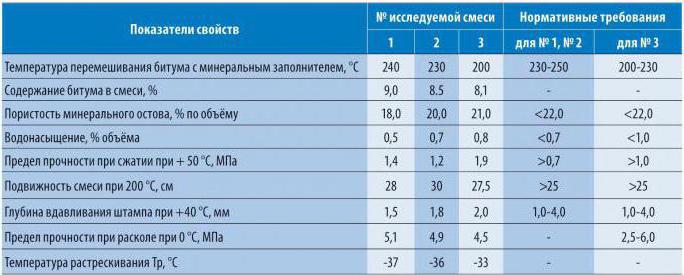
Cast asphalt is also used for paving. This allows you to maintain all the positive qualities of the track and give it an aesthetic shape and structure. Grass does not sprout through such a sidewalk, cracks do not appear. This coating is able to withstand both high weight load and temperature difference. However, the use of cast mixture in the production of paving slabs not only preserves all the useful properties of asphalt, but also creates new ones. Such a sidewalk has increased heat resistance and environmental friendliness, because the temperature of the tile is higher, which prevents the coating from emitting carcinogenic substances into the environment.
Cast asphalt is easily removed and dismantled, and it is also quite simple to reinstall. This saves money on repairs. The use of high-quality cast asphalt for production paving slabs guarantees a long shelf life of the coating, which, unlike the asphalt itself, can reach 100 years. The sidewalk made of a cast mixture is the best option for use in personal areas, because it has a high level of quality and environmental friendliness. Due to the wide range of useful properties and the absence of disadvantages, cast asphalt concrete is ideally suited for the production of paving.
P 54401-2011 “Hot asphalt concrete road. Technical requirements"Cast asphalt concrete mixture -" cast mixture, with a minimum residual porosity, consisting of a grain mineral part (crushed stone, sand and mineral powder) and viscous oil bitumen (with or without polymer or other additives) as a binder, which is laid using injection molding technology, without compaction, at a temperature of the mixture of at least 190 ° C. " Cast asphalt, depending on the temperature, as well as the magnitude and time of application of the load, manifests itself as an elastic-elastic and visco-plastic material. The difference between cast polymer-asphalt concrete is that they are produced using bitumen modified with polymer additives, a polymer-bitumen binder (hereinafter referred to as PBB).
Application in various countries
The prototype of cast asphalt concrete can be considered natural asphalt, which was used in Babylon and Nineveh. This material began to be used in European cities at the beginning of the 19th century. To do this, bitumen-containing limestones found in deposits in France (Seyssel), Germany (Limmer) and Switzerland, containing from 5 to 20% natural bitumen or heavy oil, were used. For the "cooking" of natural asphalt used large metal boilers, the mixture was laid manually. In 1829, cast asphalt was paved for the first time in Lyon, and then in large metropolitan cities (London and Paris), the laying of sidewalks and bridges with cast asphalt began. The use of the new coating had both positive and negative properties. Pedestrian townspeople were unhappy with smoking asphalt boilers and outskirts sticking to the asphalt in the summer heat. However, the use of cast asphalt has significantly reduced the noise during the movement of horses and wagons. In the crews themselves, conversation became possible. On the streets where the asphalt was poured, the traffic became so quiet that the sudden appearance of the crew frightened the townspeople, who were accustomed to the rumble of the approaching carts.
In the 1910-1950s. XX century cast asphalt found the greatest use in Germany, where they continued to improve the methods of laying, selection of formulations, the scope of application of the material expanded. In 1908, the first cast asphalt concrete was laid in Berlin and Frankfurt am Main. Since the late 1920s, Trinidad asphalt from Peach Lake has been used in casting mixtures. In the early fifties, the first paver for cast asphalt concrete was invented. In the fall of 1954, in Berlin on the Ziemensstraße, the mechanized laying of cast asphalt concrete was first tested. Already in the 1960s, cast asphalt was laid seamlessly, up to 12 meters wide, and its use shifted towards the construction of express roads. The largest object for that time in cast asphalt concrete paving was the 38-kilometer section of the Nuremberg-Frankfurt Autobahn from Tenneloe to Schlusselfeld. The so-called “Berlin recipes” used, saturated with crushed stone, provided high roughness and long-term wear resistance. The then applicable TVbit6 / 60 standard provided for the use of bitumen with penetration from 15 to 65 units for cast asphalt concrete, or a mixture of road bitumen and natural Trinidad asphalt. Previously used for surface treatment, natural sand began to be replaced by gravel treated with bitumen.
The Russian history of the use of cast asphalt is primarily associated with the discovery and development of natural deposits of bitumen-containing dolomites in the Volga region, in the Syzran region. Deposits by reserves were estimated at 22 billion. pounds. Asphalt business developed in Russia since when D.I. Voeikov, together with zoologist M.N. Bogdanov, discovered sandstone soaked with natural bitumen in Syzran district. This made it possible to establish the production of tar and mastic from local materials of excellent quality. Syzran asphalt was stronger than Western European analogues and melted at a higher temperature. Natural asphalt (bituminous rocks) was processed in significant quantities for mastic in factories near the village. Farm laborers and with. Pechersky Syzran district, including for casting briquettes, then melted at the place of laying in boilers. Both plants in the city produced 800 thousand pounds of mastic. Simbirsk asphalt was cheaper than foreign (at the beginning of the 20th century. 1 pood on average cost 35 kopecks), and was considered the best in Europe in quality. At the end of the 19th century - beginning of the 20th century Asphalt was bought by such cities as Moscow, Kiev, Nizhny Novgorod, Saratov, Astrakhan and others. All of the above types of cast materials had a distant resemblance to the compositions currently used, however, the practice of improving them, searching for the optimal ratios of the mineral part and bitumen, and additional introducing sand and gravel continued to develop.
Several research centers have been involved in modern research on cast asphalt in the USSR. However, unlike West Germany, cast asphalt concrete did not receive widespread use in the USSR. The development of compositions and the technology of using cast asphalt concrete, the study of the stress-strain state of the multilayer construction of pavement of bridge structures were carried out by prominent scientists, specialists - road builders and bridges of the State Unitary Enterprise NIIMOSSTROY, Moscow Automobile and Highway State Technical University (MADI), Giprotransmost Institute, FSUE SoyuzdorNII, Saratov State Technical University and many others.
Classification
The main principles for the classification of cast asphalt concrete are their separation according to the size of the largest particles used in the composition of the mineral material (fractions of crushed stone); the purpose of the composition; styling method. As a rule, the first of the three principles listed is used in world practice. It is used in German, Swedish (BRO 94 “Basic technical and construction requirements for roads”, chapter 6), Austrian (ÖNORM EN 13108-6), Swiss (SN 640440), Russian standards, as well as in European standards of the EN series. Classification based on the styling method (manual or mechanized) applied in Finnish normative documents . For example, the German classification of cast asphalt concrete according to the harmonized German standard TL Asphalt-StB 07 includes 6 main types: MA 11S; MA 8S; MA 5S; MA 11N; MA 8N; MA 5N.
In traditional compacted asphalt concrete, the so-called macrostructure (the content and shape of crushed stone and sand) plays a significantly larger role in the formation of the physical and mechanical properties of materials. The increased ABB content causes the fluidity of the cast mixtures, which, with the correct composition, allows us to consider this material almost as a viscous liquid that cannot be densified.
Source Requirements
In Russian national standard on cast asphalt concrete (GOST R 54401-2011) sets out the requirements for the main components of this material.
Properties of Cast Asphalt
Cast asphalt concrete is low-combustible, does not spread flame, has a half thermal conductivity coefficient compared to concrete (0.7-0.9 W / mK), and is vapor and sound insulating materials (noise reduction up to 14 dB with a layer of 35 mm). The main advantages of cast asphalt concrete over traditional compacted asphalt concrete, produced according to GOST 9128-2009, are water resistance and fatigue life, the value of which increases several times when using road bitumen modified with thermoplastic elastomers.
Disadvantages of cast asphalt: increased cost of mixtures; the need for special equipment for the delivery and laying of material; poor resistance to plastic rutting with unsatisfactory quality of selection of the composition in the laboratory or technological production errors; cracking in winter period time when using unmodified bitumen in cast mixtures with a reduced penetration rate (less than 50 units) and an increased fragility temperature according to Fraas.
Green cast asphalt concrete with embossed pavers.
Demonstration laying cast asphalt mixture on vertical surfaces.
Scope of cast asphalt concrete
Widespread in Germany have received coatings in residential and industrial premises, including in medical institutions. Such coatings, prepared on the basis of brittle bitumen, have high bending strength, low thermal conductivity, environmental friendliness and lack of smell and dust formation. Cast asphalt concrete, laid in a thickness of 20 to 35 mm, is used in combination with dense heat and sound insulation materials on concrete and wooden floors. On top of such coatings lay linoleum, carpet or ceramic tiles. Cast asphalt for flooring in Germany is subject to technical regulation.The expansion of the use of cast asphalt in Russia was largely facilitated by large bridge projects in which pavement and waterproofing systems were arranged using cast asphalt. This is the construction of a bridge across the Volga in with. Pristannoe (2000), Ladoga bridge across the river. Neva by Marino (1998), the construction of the Bolshoi Obukhov bridges of the cable-stayed system in St. Petersburg (2004, 2007), the reconstruction of the Troitsky bridge across the Neva River in St. Petersburg (2002), the Blagoveshchensky bridge in St. Petersburg (2008), the construction of flyover systems on the Ring Road around St. Petersburg (2008-2010), the construction of the Ulyanovsk bridge over the Volga River (2009) and dozens of other objects.
The lower coating layer of the bridge of cast polymer-asphalt concrete.
The practice of operating artificial structures shows that the durability of road surfaces on some large bridges in Russia is reduced by half in 2-5 years. The destruction of the coating layers of the bridge web leads to the intensive penetration of moisture, chemicals, debris directly to the waterproofing layers and damage to the latter. The unsatisfactory condition of the carriageway of bridges is one of the reasons for the destruction of structural elements of concrete artificial structures, as well as the corrosion of metal in orthotropic plates of the carriageway of metal bridges.
One of the reasons for the fragility of coatings is the use of a traditional multilayer structure on concrete spans consisting of dissimilar materials: two coating layers of traditional compacted asphalt concrete (at least 90 mm thick) in accordance with GOST 9128-2009 and a reinforced concrete screed covering the waterproofing layer. The water resistance of such a coating system and the degree of adhesion between the layers are negligible, which creates increased internal stresses in the materials. Operation of bridge structures in harsh climatic conditions, in conditions of vibration and exceeding permissible traffic loads leads to premature destruction of such systems and significant costs for their repair
In SP 35.13330.2011. Set of rules. Bridges and pipes. The updated edition of SNiP 2.05.03-84 * regulates the possibility of using cast asphalt concrete as coating materials for the lower and / or upper layers of the pavement of bridge pavement on concrete and metal spans. The document does not reflect the requirements for the type of bituminous binder used in cast asphalt, and the use of compacted mixtures on PBB is prohibited. This prohibition does not comply with the European practice of using polymer-modified bitumen, limits the practice of its use in the Russian Federation, and also potentially reduces the durability of coatings, taking into account the harsh climatic conditions of Russia. Due to their inherent physical and mechanical properties, cast asphalt concrete and cast polymer-asphalt concrete are widely used in the world practice of bridge building as coating materials for the roadway of a bridge. Their use on concrete bridge structures allows you to abandon the traditional design with concrete screed, which reduces the load on the spans and increases the service life of the coatings. In many EU countries (Germany, Austria, the Netherlands, Hungary, Finland, Sweden, etc.), cast asphalt concrete is also considered an important element of the waterproofing system, applied directly to the main waterproofing material and ensuring the joint work of the coating and spans due to the high degree of adhesion.
German national regulations on the installation of coatings and waterproofing of artificial structures, require the mandatory use of cast polymer-asphalt concrete as a protective layer of waterproofing. In Germany, the use of a multilevel waterproofing system on metal and concrete bridge constructions consisting of a primer (bitumen-containing or epoxy), a protective-bonding layer (a deposited roll web or polymer-bitumen substance) and cast asphalt concrete allows us to expect the service life of such systems without overhaul up to 30 years or more.
Statistics
Annually, according to the European Association of Manufacturers of Cast Asphalt Concrete (hereinafter EMAA), from 800 thousand to 1 million tons of cast are produced in Europe asphalt mixes. Since 2004, Russia has been included in the EMAA. The largest European countries producing cast asphalt are Germany (389728 tons in 2009) and France (216505 tons in 2009), providing more than half of the total annual output. About 50% of all cast asphalt concrete manufactured in Europe is used as a waterproofing material, including as an element of a waterproofing system for bridge structures.
Surface treatment with blackened gravel of the upper layer of the coating of cast asphalt
Test methods
At the moment, in Russia, the list of methods for testing cast asphalt concrete is determined by the standards of organizations developed by manufacturers and technical specifications, the obligations of which the manufacturer takes upon itself to use. Cast asphalt in Russia is tested for the value of the porosity of the mineral core, residual porosity, water saturation, determination of the tensile strength at split at 0 0 C, the compressive strength at 50 0 C, workability. In the EU countries, requirements for cast asphalt concrete contain functional requirements and, as a rule, do not contain specific digital values \u200b\u200bof indicators of indicators of physical and mechanical properties, limiting themselves to classification according to a large number of quality criteria. The final value of a particular indicator of the properties of cast asphalt is determined in the design documentation for the construction object or can be declared by the national annexes to the European standard (Nationally Determined Parameters), as well as by the manufacturer. The main method in determining the rheological properties of cast asphalt in most countries of the world is to determine the depth of indentation (penetration) in a sample of a flat stamp with an area of \u200b\u200b5 cm2. at constant vertical load (52.5 kg). The test is carried out on cubic samples of material measuring 7.07 x 7.07 x 7.07 cm at a temperature of +40 0 C, for 30 minutes. The magnitude of the deformation of the sample under the influence of load is measured with an accuracy of 0.01 mm. The European test methodology is based on the German method described in DIN 1996, chapter 13.
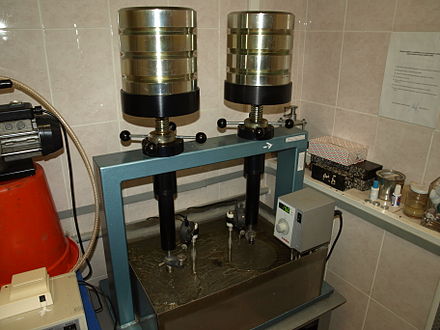
The device for determining the depth of indentation of the stamp
Technical regulation
In May 2012, Russian standards for cast asphalt concrete were put into effect -
Cast asphalt is very popular in Europe. In Russia, this type of asphalt is less common due to the high cost of equipment and the asphalt mixture itself. However, cast asphalt is the highest quality tool for the construction of new roads, parking lots and bridges.
Cast asphalt differs from conventional asphalt paving technology. The composition of both mixtures is approximately the same, that is, the components of asphalt are the same (crushed stone, mineral powder, sand and bitumen), but their proportions are different. So, cast asphalt concrete contains an increased amount of bitumen (from 8 to 10% of the total mass) and mineral powder (from 20 to 30%), which makes it malleable and to some extent liquid.
The technology for laying cast asphalt involves pouring the required area with asphalt concrete mixture. Asphalt is leveled manually or using a special installation. Compaction with a compacted asphalt roller is not required.
Features of Cast Asphalt Concrete
Cast asphalt concrete is used for the construction of roads, bridge pavement, bicycle and pavement tracks. Each type of road has its own crushed stone fractions (from 5 to 20 mm). Also, due to the properties of the mixture, it is often used for flooring in residential and other premises, as well as for waterproofing.
The advantages of cast asphalt should be noted. Unlike ordinary asphalt, cast has water resistance. Due to the fact that the asphalt mixture is not porous, water does not enter the asphalt concrete and does not destroy it from the inside. It is also harmless and more environmentally friendly. Such asphalt is not sensitive to high temperatures.
The undoubted positive qualities of cast asphalt include its durability. So, with the correct use and preparation of asphalt mix without violating the technology, the road will last 20, or even 30 years. Cast asphalt is not sensitive to salt and chemicals. Cast asphalt mix is \u200b\u200boften used for bridge pavement, as it can damp vibrations.
Convenience of laying plays a big role in the choice of asphalt pavement. Cast asphalt is laid at a street temperature of -10 °, and this is due only to the comfort of the road workers themselves, and not to the property of the mixture.
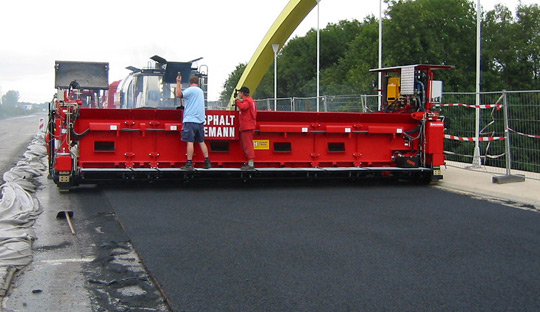
Laying is carried out at a temperature of asphalt concrete in 190-250 about. Such a high temperature promotes asphalt flow. Its consistency resembles mastic, so the asphalt itself is evenly distributed over the surface, without requiring the roller to work for compaction. To improve the performance of the cast coating, some companies add mineral powder modified with polymer additives to the mixture. This helps to increase or decrease the astringent properties of bitumen.
Cast asphalt is easy to repair and rebuild.
Cast asphalt is characterized by good adhesion, that is, the wheel does not slip on the surface of cast asphalt, even during rain. In Russia, the adhesion coefficient is increased by immersion of crushed stone (5-10 mm) in a still hot, not frozen asphalt mixture. This cast asphalt paving technology protects the road from damage by the studded wheels of trucks.
Cast asphalt concrete is suitable for laying on uneven surfaces or surfaces with complex geometric shapes. Also, the mixture is easily painted in the necessary colors, the gamut of which is very wide.
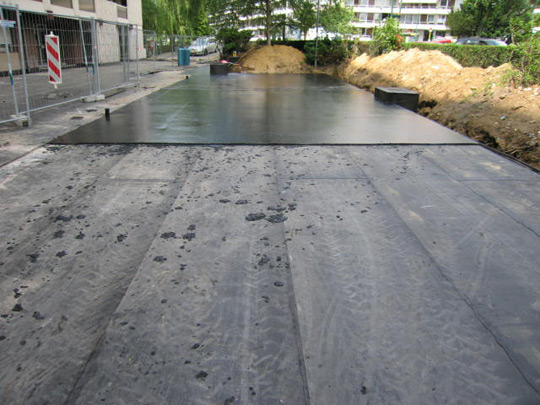
Cast asphalt paving technology
Cast asphalt is transported using a special device - kocher. Kocher is a kind of tank or tank capable of maintaining the desired state of the mixture and its constant mixing. Then the mixture with the help of a road stacker is evenly poured in the right place. The road is able to absorb the load after 12 hours.
Although the technology of manufacturing and laying asphalt reduces the number of workers involved, the use of a large amount of bitumen and mineral powder nevertheless makes the mixture more expensive. In addition, the use of special equipment during installation significantly increases the cost of cast asphalt. Therefore, while in Russia the use of cast asphalt is not very common.
The second most common after hot mixes material for patching is cast asphalt. In composition, it differs from them in a larger proportion of bitumen and the use of fine mineral aggregate. In fact, it is an analogue of natural asphalt.
The advantage of repairing with the help of cast asphalt concrete mixtures is the great strength and frost resistance of the patched areas, as well as the possibility of performing work in the winter. We will tell you in detail and in stages about the technology of using cast asphalt concrete in patching roads with cutting cards.
Cutting cards for patching with cast asphalt does not differ from the same stage of work when using any other material and is performed with the same tools and equipment. The requirements for chopped cards are almost the same - the verticality of the edges, the complete removal of damaged asphalt, the absence of sharp corners. But there are two nuances:
- The area of \u200b\u200bcards is limited to 2-3 square meters. This is due to the fact that the cast asphalt has a smoother surface and lengthens the braking distance. It is especially dangerous if, when braking, the wheels of one axle fall onto extended sections with a different coefficient of friction, it automatically enters into a skid. It is also undesirable to use cast asphalt concrete on turns. However, there is a way to get around this limitation - before the final set freeze, cover the map with fine gravel.
- Cast asphalt can reliably bond with wet surfaces. Therefore, if it is not possible, it is not necessary to finish the card to the end. But the water still needs to be removed completely, since the vapor bubbles disrupt the structure of the hardened repair composition.
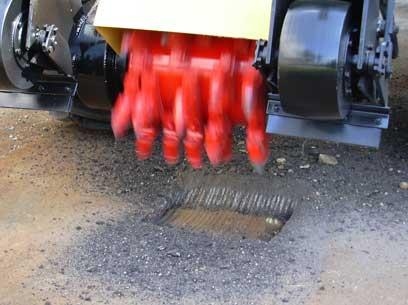
Requirements for a sliced \u200b\u200bmap: area up to 2-3 square meters, verticality of the edges, no sharp corners.
It should be noted that if the mixture is not brought from the factory, but is heated on the spot in the recycler, it is advisable to cut and clean the cards during its heating. Thus, by correctly distributing the workers so that they can prepare the required number of cards, which is filled with one load of the recycler, downtime can be completely avoided.
Paving cast asphalt
Unlike the use of other materials for patching, the bottom and walls of the cards do not need to be primed before laying asphalt. Its installation is extremely simple. Having received the cast asphalt, which is transported in a thermos-hopper, we control the temperature, it should be at least 190-220 degrees. Machines for transporting this mixture are usually equipped with special trays, from which you can unload the required amount of poured asphalt directly into the chopped card. Then the composition is leveled with shovels and trowels and remains until the final curing. Traffic on the repaired section of the road can be opened in an hour, and in winter even earlier.
It should be borne in mind that overheated cast asphalt has increased ductility and its surface tends to become strictly horizontal. The roadway has a small transverse slope. So that water does not accumulate in the repaired place, the temperature of the material to be laid must strictly correspond to its passport, and the trowels must be given the same level with the rest of the road surface.
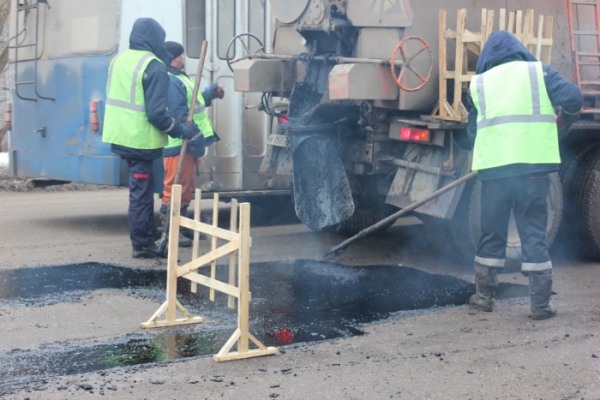
The process of laying cast asphalt is simple: unload the cast asphalt into a card, level it with smoothers or shovels.
Recycled Cast Asphalt Preparation
But most often, especially in winter, the mixture is not brought from an asphalt plant, but is prepared at the place of work in recyclers. These are devices that provide heating and mixing of the mixture. Most often they have a wheel drive and a towing device for towing.
The preparation of the mixture in this unit can be divided into several stages.
- The prepared asphalt concrete is loaded by turning the drum so that the loading door is at the top. An additional small amount of pure bitumen is recommended.
- Then the hatch closes and the nozzle lights up. The drum must constantly turn, making several revolutions in one direction or the other. During operation of the recycler, you need to carefully monitor the temperature of the mixture.
- When the paved asphalt is heated to the required value, the burner is turned off.
- The recycler is adjusted to the prepared cards, the drum is turned over with the hatch down. Opening the shutter, unload the right amount of material, then start laying the mixture.
All laying processes are carried out in exactly the same way as when delivering the finished mixture from the factory. When the recycler moves from card to card, they continue to mix the heated mixture by rotating the drum. If the temperature drops, briefly turn on the burner again.
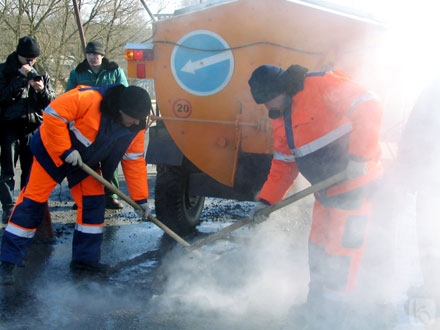
In winter, cast asphalt concrete is prepared at the place of work in the recycler.
As with any other method of sealing potholes, only full and proper observance of all technological requirements during repairs using cast asphalt allows to achieve high quality.




